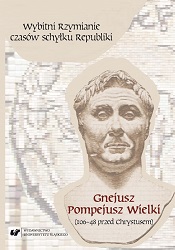Głowa Pompejusza i inne ślady spotkania Rzymian z Egiptem
Pompey’s Head and other consequences of the Romans’ encounter with Egypt
Author(s): Adam Łukaszewicz
Subject(s): History
Published by: Wydawnictwo Uniwersytetu Śląskiego
Summary/Abstract: Pompey met his tragic end on the Egyptian shore near Pelusium. Contrary to what Appian claims, Pompey was not brought there by wind sent by a daimon, but his flight to Egypt resulted from a rational calculation based upon his old relationships with Ptolemy XII, father of the young king of Egypt. Pompey trusted in his alliance with Ptolemy XIII, since he was a legal guardian to his children, and a custodian of his will and testament. However, after Pompey’s defeat at Pharsalos, the Egyptian allies treacherously murdered Pompey who had landed near Pelusium. They probably yielded to Caesar’s persuasion. Caesar waited near Alexandria for confirmation of Pompey’s death. According to Alexandrians of that time, Ceasar then acted buffoonish and hypocritical, refusing to accept the head of his enemy and accusing the king’s advisors of the horrible crime. The head was then mummified in a procedure which can be reconstructed based on the description in the Lucan’s poem about the civil war. The head of the great Roman was buried by Caesar in “the precinct of Nemesis.” A tomb of Pompey was also near Pelusium. Cleopatra’s policy of secret contacts with Caesar was successful. The later fate of Caesar and Cleopatra was largely determined by the events of 48 BC. There is no trace of the precinct of Nemesis and the said tomb at Pelusium. Only a giant column in Alexandria bears the erroneous name of Pompey’s Pillar.
Book: Wybitni Rzymianie czasów schyłku Republiki. Gnejusz Pompejusz Wielki (106–48 przed Chrystusem)
- Page Range: 183-189
- Page Count: 7
- Publication Year: 2018
- Language: Polish
- Content File-PDF

